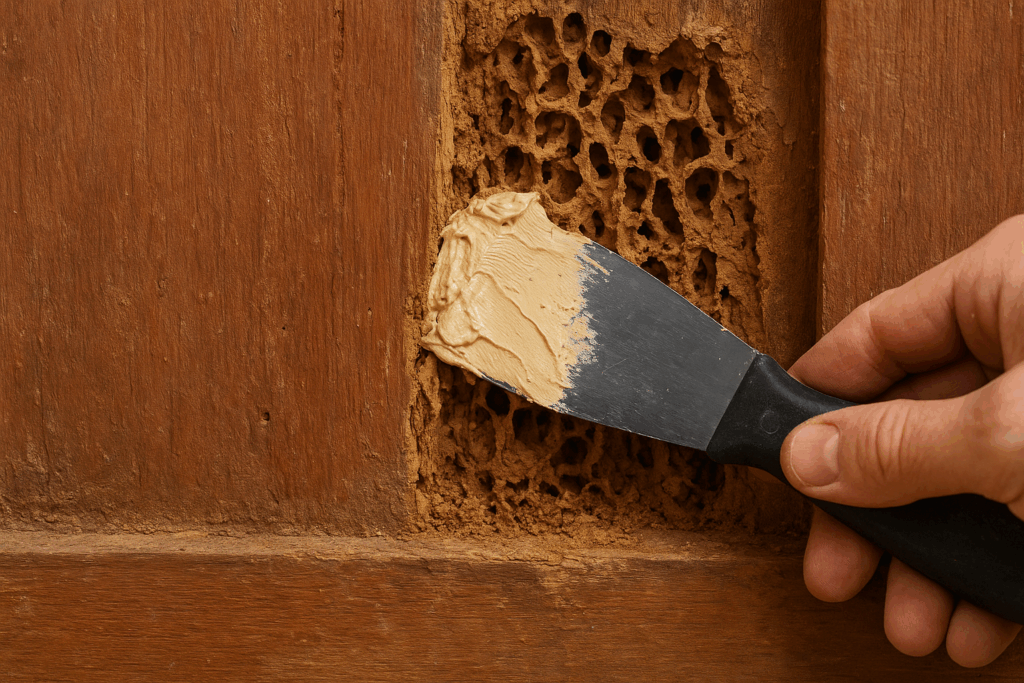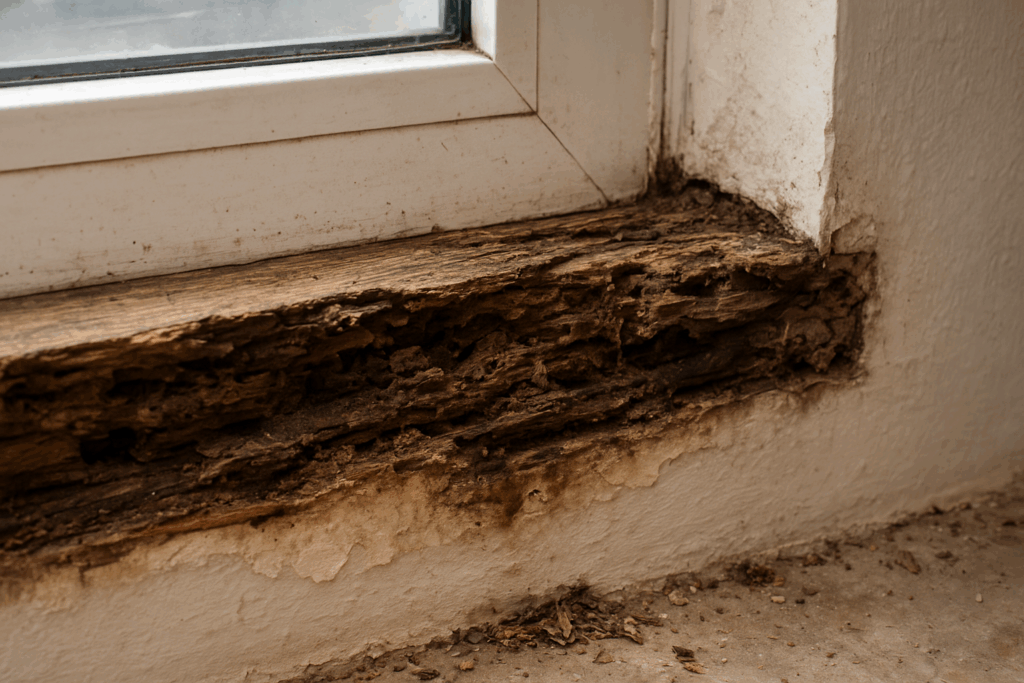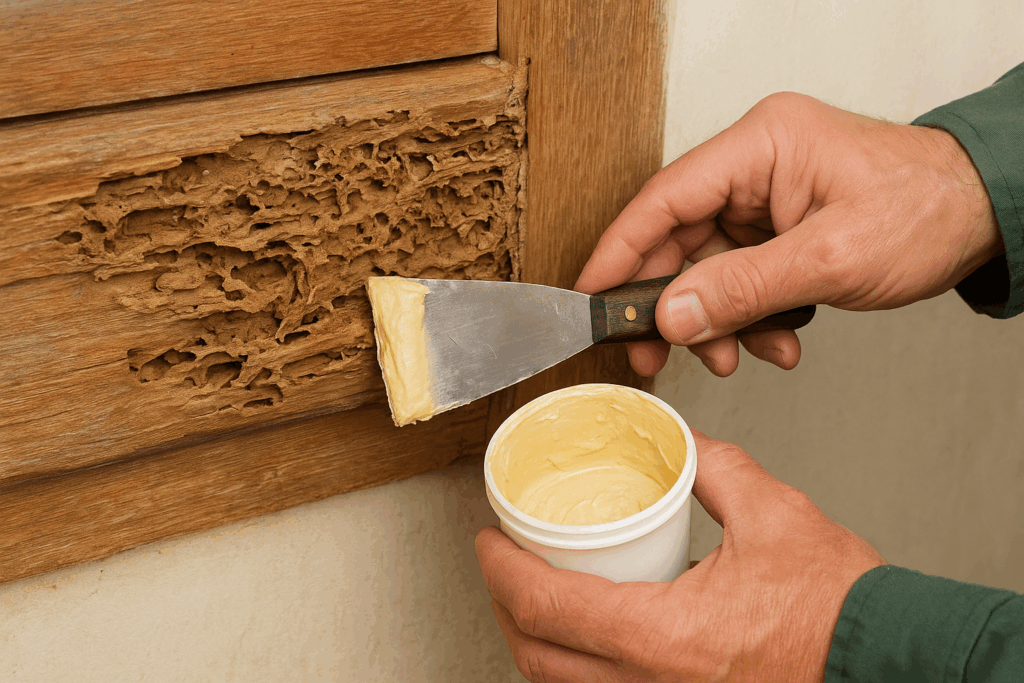Termite Damage is one of the most silent yet destructive threats to any home. These tiny pests can chew through wood, flooring, and even wallpaper—often without being noticed until it’s too late. By the time you spot the signs, the damage may already be severe and costly to fix.
But here’s the good news: with the right strategies, you can stop termite damage before it spreads and protect your property from future infestations. This comprehensive guide covers 7 powerful, proven ways to prevent, identify, and repair termite damage effectively.
1. Identify the Warning Signs Early
Early detection is your best defense against extensive termite destruction. Most homeowners fail to notice the initial signs because termites work quietly behind walls and under floors. Learning what to look for can save you thousands in repair costs.
Key Warning Signs of Termite Damage:
- Hollow-sounding wood when tapped.
- Mud tubes on walls, foundations, or crawl spaces.
- Discarded wings near windowsills or entry points.
- Sagging floors or ceilings.
- Tiny holes in drywall or wooden surfaces.
- Faint clicking sounds from inside walls.
If you notice even one of these symptoms, act fast. Early termite detection can mean the difference between a minor repair and a major reconstruction.
Quick Tip:
Schedule a professional termite inspection at least once a year to detect hidden infestations before they spread.

2. Eliminate Moisture – The Termite Magnet
Moisture is the number one attractant for termites. Damp, humid environments create the perfect breeding ground for colonies to thrive.
By managing moisture levels inside and outside your home, you significantly reduce the chances of termite infestation and ongoing termite damage.
Effective Moisture Control Methods:
- Fix plumbing leaks immediately—under sinks, behind walls, or near foundations.
- Use dehumidifiers in basements and crawl spaces.
- Ensure proper drainage around your home’s perimeter.
- Clean gutters and downspouts regularly to avoid water pooling.
- Install proper ventilation in bathrooms, kitchens, and attics.
Moisture vs. Termite Risk Table
| Area of Concern | Common Issue | Solution to Prevent Termite Damage |
|---|---|---|
| Basement & Crawl Spaces | High humidity | Install vapor barriers or dehumidifiers |
| Roof & Gutters | Water accumulation | Clean regularly and repair leaks |
| Bathrooms & Kitchens | Hidden plumbing leaks | Regular inspection & maintenance |
| Exterior Foundation | Poor drainage | Grade soil away from home |
When your home stays dry, termites won’t have the damp wood they need to survive and multiply.
3. Seal Entry Points and Cracks
Even the smallest crack can be an open invitation to termites. They can enter through gaps as thin as a credit card. Sealing every entry point is a crucial step in preventing termite damage before it begins.
Steps to Seal and Secure Your Home:
- Inspect your foundation and look for small gaps or cracks.
- Seal windows and door frames with high-quality caulk.
- Install weather stripping to block hidden entryways.
- Repair damaged screens on vents or crawl space openings.
- Fill wall voids and seal expansion joints with foam sealant.
Pro Tip: After heavy rainfall or temperature changes, recheck sealed areas—cracks can reappear as materials expand and contract.
Keeping your home sealed properly creates a strong physical barrier against termite intrusion.
4. Use Termite Barriers and Treatments
When natural prevention isn’t enough, termite barriers and treatments are the next line of defense. These can be chemical or physical systems designed to repel or kill termites before they reach your home’s foundation.
Common Termite Barrier Types:
| Barrier Type | Description | Best For |
|---|---|---|
| Chemical Barriers | Liquid termiticides applied around the foundation to kill termites on contact. | Homes with previous termite activity. |
| Physical Barriers | Stainless steel mesh or sand barriers installed during construction. | New homes or renovations. |
| Baiting Systems | Bait stations placed around the home attract and eliminate colonies. | Long-term prevention and monitoring. |
Recommended Practices:
- Reapply chemical treatments every 5 years for maximum effectiveness.
- Use eco-friendly or low-toxicity solutions if you have pets or kids.
- Combine multiple treatment types for enhanced protection.
If you’re unsure which method suits your home, consult a professional pest control expert for a customized plan.

5. Remove Termite Food Sources
Termites thrive on cellulose-rich materials—essentially anything made of wood, paper, or plant matter. Reducing their food supply means cutting off their survival lifeline and preventing further termite damage.
Steps to Remove Food Sources:
- Store firewood and lumber at least 20 feet away from your house.
- Remove tree stumps, fallen branches, or dead roots from your yard.
- Avoid using mulch directly against exterior walls.
- Discard cardboard boxes stored in damp areas.
- Replace damaged or rotten wood immediately.
Outdoor Wood Risk Chart
| Outdoor Material | Termite Risk Level | Preventive Action |
|---|---|---|
| Firewood piles | Very High | Store 20+ feet away |
| Tree stumps | High | Remove immediately |
| Wooden fences | Medium | Treat with termite-resistant coating |
| Mulch beds | Medium | Use gravel or rubber mulch alternatives |
Removing what termites love most—wood and cellulose—helps make your home uninviting to them.
6. Call a Professional Termite Expert
Sometimes, DIY methods simply aren’t enough to stop termite damage, especially if the infestation is already advanced. That’s when it’s time to call in a professional termite control service.
Why You Need Professional Help:
- Experts can locate hidden colonies deep within walls or foundations.
- They use industrial-grade treatments not available in retail stores.
- Professionals provide warranty and follow-up visits for lasting protection.
- They can give a comprehensive termite report for insurance or resale.
What to Expect During an Inspection:
- Detailed visual inspection inside and outside your property.
- Use of moisture meters, thermal cameras, and sound detection.
- A customized treatment plan based on infestation level.
- Preventive maintenance recommendations.
7. Maintain a Termite-Free Home with Regular Care
Once you’ve handled the current problem, the key to stopping termite damage permanently is consistent maintenance. Even a small lapse can allow termites to return.
Regular Maintenance Checklist:
✅ Inspect wooden furniture and walls every 3–4 months.
✅ Keep your lawn trimmed and your garden well-drained.
✅ Schedule annual professional inspections.
✅ Replace damaged or damp wood immediately.
✅ Avoid stacking papers, boxes, or firewood near your home.
Seasonal Termite Control Table
| Season | Termite Risk | Action Plan |
|---|---|---|
| Spring | High | Inspect for new swarms, treat perimeter |
| Summer | Moderate | Monitor moisture levels, trim vegetation |
| Fall | Medium | Seal entry points, clean gutters |
| Winter | Low | Check for hidden damage, repair weak spots |
Keeping up with this schedule ensures your home stays safe from recurring termite issues.

Bonus Tip – Choose Termite-Resistant Materials
If you’re building or renovating, consider using materials that termites hate. Modern construction offers many termite-resistant options that reduce the risk of termite damage long-term.
Recommended Materials:
- Treated lumber with borate compounds.
- Metal or concrete foundations instead of wood.
- Composite decking materials (plastic + wood blend).
- Fiber cement siding for exteriors.
- PVC baseboards instead of wooden trims.
These materials are cost-effective, durable, and unfriendly to termites, making them a smart long-term investment.
Conclusion – Stop Termite Damage Before It’s Too Late
Termite damage doesn’t happen overnight—it’s the result of small problems ignored over time. But the good news is, by applying the 7 powerful ways outlined above, you can protect your home and prevent the spread of termite destruction before it’s too late.
Let’s recap the key points:
- Identify signs early and act fast.
- Keep moisture levels low.
- Seal every crack and opening.
- Use reliable termite barriers and treatments.
- Eliminate all possible food sources.
- Call professionals when needed.
- Maintain regular termite checks and home care.
Remember, prevention is far cheaper than repair. Protect your investment, safeguard your family’s comfort, and keep your home termite-free for years to come.